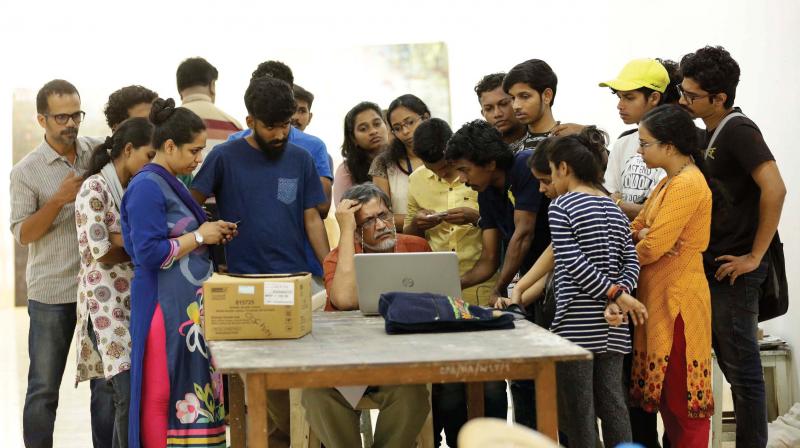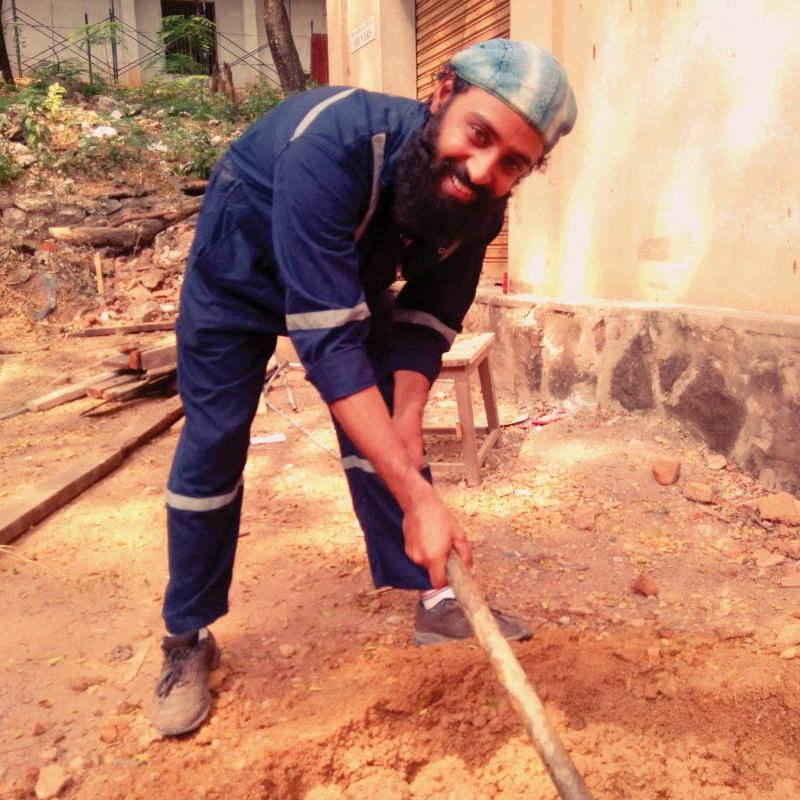Creating a dialogue with the artist
An art camp in the capital has brought together students and artists from across the nation.

Sapna Karn sits on the floor, sticking pieces of cloth on a newspaper. The serious face makes it difficult to ask her about the curious work. Curious because she is sitting in a room for painting, and this looks like craft. There are other rooms like these, and the campus outside too is filled by art students from across the country. A little hut at the entrance says that a national art camp has been put together by the Kerala Lalithakala Academy and the Fine Arts College, Thiruvananthapuram. Students from fine arts schools across the country have come, so have renowned artists taking the place of mentors or resource persons.
Indrapramit Roy, one of the resource persons and associate professor at the Baroda University, too thought the same when he saw Sapna at work, that this was craft and she was in a class for painting. "But you should always understand the context, understand where they come from. She was working with children in juvenile homes across the country. It is a give and take. I also learn something from these students," he says, sitting in a room with R. Nandakumar, art historian and culture critic. Nandakumar is screening a few documentaries as part of the art camp. "There is a lot of crisis in art education," he says. Nandakumar talks of new media, the digital, computer-generated media. And the general perception that if you don't try your hand in new media, you lag behind. You shouldn't be doing something just because everyone else around you is. Criticality is lost, it cannot be substituted by what's novel. "We have to prepare the students and make them aware of these issues," Nandakumar says.
 Sculptures from the Myladi camp
Sculptures from the Myladi camp
The whole idea of the art camp is to bridge the gap between the artist and the public, says Fine Arts college principal Tensing Joseph. "The limitations and the monotony of working within a studio should break. We need to create a different ambience. Art education institutes are isolated from the public. An artist is part of the society but that connection is now lost. What happens in the space between the studio to the gallery - that should be a public space. Artists can interact with the public, make it more democratic, talk about the techniques and strategies. So it becomes a social space."
Tensing believes we depend on external forms of a Euro-centric art. And the pedagogical practices are affected. "It has all become about making it in the art market," he says. There was an art boom in 2005 when many artists got rich. Art students who got fascinated by this, want to get rich fast, he says. Tensing goes on to talk about the artwork 'Fountain', a porcelain urinal, by Marcel Duchamp, which was completed 100 years ago. "The idea of art installations came after that." Even as he speaks, walking on the campus, there is a student from Delhi, creating an installation with mud. "I like working in a community space, doing site specific work," says Mohd. Wahid, who is doing his Masters in Sculpture at the Baroda University. The art camp covers painting, sculpture, graphics and applied art.
 Mohd. Wahid
Mohd. Wahid
"All over India, there are such workshops, but mostly for professionals. It is the first time I find one for students. That is a positive thing. Every art school has its own culture. When students from different arts school come together, there is an exchange happening. Students who have come from Rajasthan are seeing coconut trees for the first time. They don't see such rich green otherwise, only urban colours. So there is an exchange in thoughts happening," says Anant Nikam, faculty at the JJ School of Art, and a resource person at the art camp. Outside the classrooms, near the front gate, are a series of sculptures that were made in an art camp recently at Myladi. "Stone carvings made after going to a village where such works are made, and after studying them," explains Bhagat Singh, faculty at the Fine Arts College. Pramod Sharma from Bhopal, artist VK Rajan, both of them resource persons and were part of the Myladi camp, say it is remarkable how the students made them in such a short time.
Back in the painting class, Sapna has turned to talk to a visitor. "I paint too, the clothes and the threads," she says, breaking into a smile, as she finds words to express her work. It is not as simple as it looks, like Indrapramit Roy observed. Sapna gives a catalogue to understand it better - 'Rehabilitation of Children in Conflict with Law, a pilot project by Sapna Karn'. She has been working with children in juvenile homes, across the country. The work she is putting together on the newspaper is of a little girl who was sold by her aunt to be a prostitute. "Her story is roaming around in my head and I am drawing her," Sapna says. The camp with its varied stories from across the country will conclude on January 22, when the closing ceremony and the art exhibition that follows will be inaugurated by the Chief Minister.

